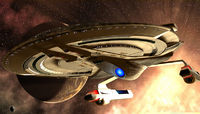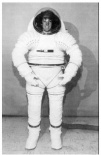Epsilon-Delta: Difference between revisions
No edit summary |
mNo edit summary |
||
| Line 1: | Line 1: | ||
Epsilon-Delta was a modified Soong-Type Android programmed to (1) minimize risk and casualties in the course of Starfleet missions and (2) better understand interstellar social dynamics. | Epsilon-Delta was a modified Soong-Type Android programmed to (1) minimize risk and casualties in the course of Starfleet missions and (2) better understand interstellar social dynamics. She was one of four Epsilon Androids emerging from a joint-program commissioned by [[StarFleet Intelligence|Starfleet Intelligence]], the [[VulcanScience Academy]] and [http://memory-alpha.org/en/wiki/Starfleet_Corps_of_Engineers Starfleet Engineering Corps], under the direction of Federation cyberneticist [http://www.wiki.starbase118.net/wiki/index.php?title=Epsilon-Delta#Profile_on_Dr._Helen_Mirren.2C_PhD Helen Mirren]. | ||
==Starfleet Data & Physical Statistics== | ==Starfleet Data & Physical Statistics== | ||
Revision as of 05:43, 4 June 2011
Epsilon-Delta was a modified Soong-Type Android programmed to (1) minimize risk and casualties in the course of Starfleet missions and (2) better understand interstellar social dynamics. She was one of four Epsilon Androids emerging from a joint-program commissioned by Starfleet Intelligence, the VulcanScience Academy and Starfleet Engineering Corps, under the direction of Federation cyberneticist Helen Mirren.
Starfleet Data & Physical Statistics
|
|
| USS Discovery-B | ||
|---|---|---|
 DECOMMISSIONED | ||
| ||
- Rank: Lt. Commander
- Assignment: U.S.S. Discovery-B
- Service Number: SP-812-813B [MIA]
- Last Position: Chief of Security
- Full Name: Epsilon-Delta
- Species: Modified Soong-Type Android (Mark IV)
- Date of Activation: December 1, 2358
- Date of Deactivation: August 10, 2386
- Place of Origin: Utopia Planitia, Mars
- Gender: Assigned as Female Stardate 238306.17
- Height: 5'7 1/2" (1.7145m)
- Weight: 200.75 lbs (.091 m.tons)
- Hair Color: Black (variable)
- Eye Color: Black (variable)
- Skin Tone: Pale (variable)
- Distinguishing Attributes:
- With proper command clearance and during properly authorized emergencies, Epsilon-Delta may assume control of critical command computer systems without the use of any tactile or audio-visual interfaces.
- Although she could directly communicate with most LCARS and non-weapons-based Federation-compliant technology, Epsilon has stated in her internal log that she finds audio and tactile manipulation "stimulating."
- This personnel file contains declassified material from stardate 238607.10. The officer is M.I.A. For more information please contact the Betazed Institute.
Family
- Marital Status: Single
- Parents Helen Mirren, MD, PhD.
- Siblings
- Epsilon-Gamma: (Mark III) Location is Epsilon Lab, Station Deep Space 285.
Epsilon Gamma is designed for zero-gravity operation and as a single occupancy life-vessel in vacuum conditions and liquid environments.
- Epsilon-Beta: (Mark II). Location is Epsilon Lab, Station Deep Space 285.
An emotional memory software prototype, currently at Epsilon Lab holographic mainframe.
- Epsilon-Alpha:(Mark I) Location is n/a.

 (right to left)
Early Mark III designs.
(right to left)
Early Mark III designs.
Profile on Dr. Helen Mirren, PhD [MIA]
(Dr. Mirren, Omnicron Theta 2337)
Dr. Mirren was the director of the Epsilon Program, a member of the Borg Defense Initiative and a senior staffmember on Project Voyager. She went Missing in Action in the Avalon Sector, Deep Space 285.
Early in her cybernetics career, Mirren initiated a variety of independent projects and conducted a period of research at the Omnicron Theta cybernetics research colony before it's demise in 2336. Dr. Mirren's reputation is well-known in the interstellar cybernetics community. She was one of the few Starfleet experts on Soong-type androids to have studied with Dr. Soong.
Mirren's family ties date back to Ancient Earth before the Eugenics Wars. Her doctoral thesis was on Khan Noonien Singh and the exploits of James Kirk and U.S.S. Enterprise-A.
She was under unique entry restrictions when traveling within the Imperial Klingon Empire. Although Dr. Mirren publicly stated a refusal to work outside the Federation, her record of achievement can be traced to Romulan and Klingon space.
Epsilon-Delta Operational Log
Pre-Starfleet
- Information has been classified at the request of Dr. Helen Mirren, PhD.
Starfleet Life
- 238406.17 - Completes training cruise at USS Centris.
- 238412.01 - Transferred to Utopia Planitia for further programming and hardware modification.
- 238406.17 - Promoted to Lt.JG and assigned as Chief of Operations, USS Discovery-B.
- 238502.06-238505.10 - Assisted in investigation of alien derelict in Avalon Sector and evacuation of Discovery-B following successful hijacking of Discovery-B by rogue Son'a agents. Delta encountered an ancient self-operating library which downloaded the contents of its database before destroying itself. [1]
- 238506.04 - Underwent refit at Deep Space 285 following extensive repair to mechanics. Positronic unit intact.
- 238506.15 - Encounters positive prediction error and re-experiences pre-Starfleet memory.
- 238507.22 - Assigned as Chief of Ops to USS Constitution-B while Discovery-B undergoes repair at Deep Space 285 .
- 238507.30 - Promoted to full Lieutenant with all rights and privileges.
- 238507.30 - 238510.05 Delta assists in mass evacuation of Genura III non-Federation colony in Avalon Sector.
- 238510.05 - Personality interaction routine is upgraded.
- 238603.15 - Promoted to Lt. Commander with all rights and privileges. Transfers to Marine Corps and rank of Major aboard USS Discovery-B. Awarded Merria Medallion[2] and Nebula Bar.[3]
- 238611.19 - Assigned as Chief of Security, Discovery-B
- 238607.10 - Hardware repurposed to Epsilon Program on DS285. Declared M.I.A. by Dr. Rama Sumataran, Avalon Sector, Deep Space 285.
(On stardate 238305.28, under extraordinary circumstances, Captain Tyr Waltas, CO, USS Discovery-B, ordered Dr. Helen Mirren to disclose classified information relevant to Epsilon-Delta's origins. The source of following information is derived from classified debriefings, academic texts and journal articles from stardate 235812.01 until 238305.28.)
Background
The Epsilon Program was jointly commissioned in 2372 by Starfleet Engineering Corps and the Vulcan Science Academy. Epsilon Delta's primary and secondary directives are (1) to minimize risks to civilians and Starfleet personnel and (2) better understand interstellar social dynamics. Much of the Epsilon series blueprint is classified under protection of Starfleet Intelligence but the narrative primer is accessible in this database.
Epsilon-Delta was the fourth model in the Epsilon series and the second of two functioning Epsilon units enlisted in active-duty in Starfleet.
The Delta model featured breakthroughs in our understanding of new technologies acquired throughout the known galaxy during the last three decades. Modification to the Soong-based architecture included security precautions designed to curtail the possibility of using the machine as a weapon against the Federation.
U.S.S. Voyager and the Eugenics Movement
Research Foundations of the Epsilon Program
The Epsilon series is based on the work of Dr. Noonien Soong, creator of the Data, Lore and B4 androids as well as new findings following the return of the highly-modified U.S.S. Voyager. Drawing from Senior officer's logs, mission debriefings, computer core logs and the Emergency Medical Holographic runtime log as well as EMH duty-officer logs, Starfleet Engineering Corps and the Vulcould Science Academy discovered new theoretical relationships between positronic theory and Borg technology as well as restricted research on non-Federation eugenics theory and ancient Earth DNA research. The Epsilon operating system is dependent on the Soong-based architecture and could only run specified hardware, of which there are only four models, one in mothball and this model M.I.A. The Gamma and Beta versions are assigned to special duty at the Betazed Institute. Epsilon synthetic lifeforms are a benevolent convergence of the aforementioned technologies, serving the Epsilon Program's primary and secondary missions in Starfleet and to minimize casualties and better understand interstellar life, respectively.
There are four synthetic lifeforms each codenamed Epsilon, housed in separate modified Soong-type cybernetic architectures (designed to support separate Epsilon organisms). Each is progressively designed, the first ("Epsilon-Alpha") was developed after approximately 17,520 hours of research projects culling data and ship schematics from the modified USS Voyager upon its return from the Delta quadrant, and its research contributions to the Borg Defense Initiative.
Construction Primer
The Epsilon is a balance of synthetics, breakthroughs in cybernetics and an experiment in form and function. Her hardware design is modifiable. In accordance with Starfleet regulations, aboard USS Discovery-B, the Chief Medical Officer and Science Chief possess separately packaged critical data regarding cybernetic functions and the Chief Engineering Officer has command clearance authorization to override all on-board equipment. Epsilon's schematic is also accessible by authorization of her Commanding Officer.
Although it may sound counter-intuitive in a design sense, the internal structure surrounding her cybernetic brain has been designed for durability and limited access. (See Holography & Salvaged Memory)
Starfleet Intelligence was intrigued by the mission potential of an easily deployable, re-assignable physiology using cybernetics. Though many designs were shelved, they remain in testing at multiple projects currently being developed for the future Mark V Epsilon at Betazed Institute. (See bionanetics and externals).
Starfleet Engineering Corps rigorously pursued an systems integrated designed to fool-proof reverse engineering attempts on the Epsilon series, developing a semi-modular design scheme that deters unauthorized disassembly. Comprehensive analysis of hypothetical and actual missions scenarios showed that the highest probability Epsilon-Delta would be damaged beyond repair would occur by intentional, pre-meditated subterfuge by Starfleet personnel or a member of the Epsilon project to gain access to her positronic brain.
Final analysis by Starfleet Intelligence concluded that the Epsilon Lab modify the basic Soong Architecture, so that in the event of catastrophic circumstances, her design safeguard positronic assets at the expense of external hardware, synthetics and cosmetic function. (See Emergency Safeguards)
Holography & Salvaged Memory
The Epsilon-Delta holographic program is based on surgically-salvaged memory engrams of post-assimilated individuals, functioning within the run-time environment of the Soong-Type positronic brain using the Zimmerman/Barclay holographic protocol system. Because the engrams are salvaged, Borg nanotechnology firmware has been embedded into the Soong runtime environments; the cybernetic architecture developed by Dr. Noonien Soong transacts memory engrams between the Epsilon synthetic neural structure housing the salvaged consciousness.
Separation of the hardware from the organism has proven risky, often resulting in the loss of memories not stored in the positronic architecture. Tragically, a great deal of the memory salvaged was lost in the original transfer (Epsilon-Alpha) and only partially salvaged in the consequent endeavor (Epsilon-Beta; Gamma). Epsilon-Delta is the youngest and most advanced model. The Beta model is housed within prototype nanetic firmware, and it's holographic storage needs required vast processing power surplus available on subspace stations, starbases and Galaxy-class starship computers. The Gamma model, though nearly identical to the Beta model in terms of software, can be mobile for relatively short periods and must be tethered to an observation pod; but can operate in environments the Delta series could not, such as deep-gravity oceans.
Holographic and cybernetic technology designed to support the Epsilon artificial lifeform were detectable on the current Starfleet lifeform index [4][5]. Using a modification of the Soong-based design and research in synthetic organism, the Epsilon series is a life-support solution for an assimilated Borg individual whose connection to the collective has been effectively severed. The individual's consciousness is preserved within the Zimmerman/Barclay holographic operating system. The prime synthetic biological specimen was detectable on modified sensor equipment to assist or prevent officer from going M.I.A. (See section on Holography & Salvaged Memory). For the purposes of this primer Epsilon shall be described as a synthetic organism, as opposed to an artificial lifeform. Indeed, Epsilon-Delta mirrors the evolutionary relationship between a joined Trill and it's symbiont. Summarizing her design principle, Dr. Mirren stated as part of this personnel interview, "I drew from a long tradition in biomimetics, and chose to exploit the Soong type positronic neural architecture, which thrives through continuous stimulus, much like a gifted child could thrive in a safe, resource-rich environment."
Parapsychology & Sentience
(figure - left to right: Dr. Eugene Lee, Dr. Helen Mirren)
Theoretically, each of her decisions and actions are determined by her mission to explore and investigate possiblity for new types of interaction and communications, within circumstances of each mission scenario. It is worth noting, all of her decisions are governed by the primary task of minimizing risks and casualties in the course of Starfleet missions.
In theory, the modfied Soong-Barclay artificial intelligence structure simulates cognitive functions and relies strongly on research in interstellar behaviorial psychology paradigms. The quality of sentience is based on theory that by constantly reanalyzing stimulus and interactions with her peers, Epsilon produces new behavior that her peers will recognize and accept as equivalent to emotion, self-awareness and a state of dream. Although the architecture of Epsilon's personality is built on the Soong architecture, the Epsilon program's mission endeavors to improve the highly flexible interaction models Dr. Soong tirelessly explored. Delta's written Academy counseling exit exam matched a psychological profile similiar to Vulcans.
The case for sentience builds. Unlike previous Soong-type Androids, the Epsilon series units are not recognized as sentient under Federation law; and have yet found a landmark event to prove their sentience. Until the event(s) whereby a legal precedent is presented in a tribunal or Federation court requesting such evidence be provided as necessary in their defense, Epsilon-Delta's rights as a sentient remain in a state of legal purgatory. A battery of Starfleet and non-Federation psychological tests hypothesize that Epsilon-Delta is aware of its own construction. As of stardate 238305.28, all Starfleet officers holding the position of Ship's Counselor have access to this declassified data.
Additionally, the artificial lifeform developed to house her holographic matrix continually evolves. The realm of her neural activity occurs in the interaction between hardware-software. Recent advances in hardware, including an emotional memory bank, raise new questions and capacities, such as her ability to detect a lie or respond verbally and non-verbally to emotional stimulus.
Epsilon-Delta has verbally expressed a desire to continually evolve healthy interpersonal relationships, stating it is essential to the integrity of her program to mirror the behavior of her peers and role-models. Perhaps Starfleet is the ideal environment for her, with it's clearly outlined hierarchical social structures and routinized activity. As she plays roles of subordinate-ranking officer to commanding officer, a patient to doctor, and in the case of Dr. Helen Mirren, director of the Epsilon Program, a child to a parent.
(figure - left to right: Dr. Helen Mirren, Epsilon-Delta, circa 2383)
As she negotiates the most efficient language (both verbal and non-verbal) needed to maintain peak operability, useful information is stored and rewritten and secondary non-essential data recompiled into engrammatic, encapsulated data and reanalyzed during non-critical periods of operation. The reanalyzed experience subroutube is designed to evolve her personality interaction routine. Though the process is immediate and under Epsilon's direct control, some theorists believe sensory data is, in this order:
- sent via secure subspace networks to Epsilon Lab
- then positronically stored in her onboard memory,
- and processed by the synthetic lifesign via the Barclay/Zimmerman holographic matrix.
According to internal logs examined Epsilon Lab scientists, a great deal of interaction data is analyzed real-time in off-duty social environments. Although she could intelligently timeshift her reanalyzation of her experiences to non-strenuous relaxation phases or low-power modes, much of this data is filed during live interaction. Whitehall believes that this is learned behavior, mirroring the paradigms of some of the galaxy's habitual, nervous writers, artists and possibly military personnel.
Indeed, new data corroborates the above is observable during shore-leaves and off-duty periods, as Epsilon-Delta has shown an affinity for exploring holodecks and historical biographies from figures throughout the galaxy, and frequently interacts with holographic simulations.
Some cultural theorists believe Delta also possesses what might be perceived in many cultures as a fierce sense of loyalty, as evident in her voluntary assignment in the security and her record as a former marine platoon leader of her assigned vessel, USS Discovery-B. The notable exception to this theory is the director of Epsilon Program, Dr. Mirren.
Bionanetics & Externals
The function of the Delta exterior is both cosmetic and highly modifiable in the fabrication period prior to her activation
Her external surface in contact with airborne environment is an organic, malleable compound designed to instantly become an adhesive and detour attempts at disassembly and access to the synethetic lifesign shell running the Barclay-Zimmerman holography. Beneath this surface is a duranium shield that acts as a sensor-resistant quantum material. Remote hacking with a tricorder is difficult due to the quantum obfuscation of positronic action. The same shuttle-grade duranium is also machined into a single-molding that surrounds the positronic unit. Additionally, The malleable skin compound could be re-programmed with medical or engineering expertise.
Wired access to her neural network is restricted to the use of proprietary cabling, whose design is classified. Blueprints are available to the CSO, CEO and CMO aboard USS Discovery-B and senior Epsilon Lab personnel on DS285.
In several mission scenarios, Starfleet Intelligence observed her ability to board, without authorization, non-Federation vessels to evade intruder alert systems. Following the successful test, Starfleet Intelligence also required the Delta unit be outfitted with safeguards to prevent and deter the opportunity she be lost to enemy hands (see section on Emergency Safeguards).
Limits Against Directed Energy Diffusion
The Delta series uses the same duranium-based alloys used to construct many types of Federation-compliant vehicles and Starfleet-grade housing. Over seventy percent of her construction is designed to withstand continuous stress and/or diffuse directed energy within the standard absorption rate of a Starfleet-grade warp-capable hull.
Although sturdy, Epsilon-Delta is not totally indestructible. She is vulnerable to long-term concentrations of ethereal or directed energy, including energy emitted from phasers, disruptor fire, quantum explosives and matter/anti-matter collisions.
Water Survival
Epsilon is technically certified in water survival techniques and she could travel in most liquid environments plus 1 unit above standard starship's gravity at an average of 1.07 knots. However, her capacity to remain in a high volume of water exceeding her mass decreases exponentially over time. Most of Epsilon-Delta's solid mass is tonnage from duranium-based materials protecting her positronic brain. In summary, although Epsilon-Delta could remain afloat by continuously converting hydrogen into kinetic energy required to sustain flotation, she is still subject to the laws of conservation of energy and would lose energy efficiency over time. Also, degradation of the surface compounds in certain liquid environments would likely trigger safeguard mechanisms to protect the positronic brain from damage.
Epsilon Lab research & development continued to test her hardware capacity to operate in liquid environments within her existing design long after her viral infection and subsequent M.I.A. A nautical weight was added to compensate for inertial loss in liquid environments through use of a single experimental anti-gravity module powered by the primary battery. The mark III (Epsilon-Gamma) demonstrated that energy efficiency costs outweigh the collateral cost of deploying Delta in liquid environments.
Memory
In standard operating mode, Epsilon-Delta could consecutively record up to 7900 petabytes of data/milisecond. By default, storage capacity is prioritized for observational data relevant to crew behavior and mission success, then self-monitoring protocols, and lastly for monitoring external systems such as her assigned vessel's ship routines and crew logs. This data is continuously uploaded via secure subspace to DS285.
Epsilons could self-erase any recorded information. Her short-term memory cycle prioritized the protection of life over tasks devoted to high-bandwitch memory operations between her core and the main computer network, dumping non-essential data if necessary to the nearest subspace communication relay in the event of a catastrophic processing error. However, control of her memory functions is highly flexible in part to the brilliant work of Dr. Soong in positronic architecture and she could reverse aforementioned prioritization if a logical analysis dictated last-minute erasure (or vice versa) would save lives.
Memory transfer in Soong-type Androids is a critical asset in mission success, sometimes leading to surprising results. In one hostage scenario involving USS Discovery-B and an alien artificial intelligence, [6] Delta copied the contents of a damaged alien digital archive shortly before it's failure, inadvertantly retrieving the most succinct and complete finding of their extinct civilization.
Energy
All Epsilon units use various methods to store, draw and deplete energy, depending on environmental circumstances. Besides continually shunting kinetic energy into a storage battery, Epsilons could convert water and synthehol into energy and draw power from UVA/UVB radiation. Rollover energy not used during duty shifts is usually sent to a reserve battery as well as the main battery which cycles energy between systems to maintain optimal efficiency.
It should be noted that Epsilon could share stored energy with compliant systems, such as tricorders, phasers and some mobile life-support systems.
In two improvised test scenarios, Epsilon was able to survive in desert climates and traverse great distances during daytime using abundant solar energy. Epsilon also used battery heat to liquify ice in Antarctic Earth, converting the water into hydrogen energy. Though Epsilon-Delta may continue to function well into the next century, test scenarios show that a total depletion of her energy reserves could be quickly accomplished through continuous unmanaged use.
Sensors
As Epsilon-Delta was designed to be deployed into exploratory mission scenarios, she is outfitted with a compact, but modular sensor and software package based on the last three decades of Federation research into matter, subspace and medical sensor technology.
The sensor apparatus is non-variable in range and extends to a diameter 12 meters from Epsilon's cranial module. It was designed as a navigational and exploratory system. The sensor system is capable of detecting subtle changes across distances and between obstacles, reading biosigns and environmental factors such as noise, light, heat and even data equivalent to the olafactory experience. The olafactory function was initially developed as a safety precaution against toxic airborne compounds.
Epsilon Delta employs pattern recognition software with transmitter/receiver hardware and optic sensors. Utilizing sonar, the EMG spectrum, and a subdermal polymer sensitive to several thousand pressure points per millimeter, Epsilon's situational awareness works to continuously:
- send feedback to dexterity hardware to manipulate her environment;
- relay information to Starfleet extrasensory sciences equipment;
- store environmental information within her memory;
- detect surrounding bio-signs;
- cross-reference non-classified medical knowledge with her peers' typical behavior;
- identify physical injuries in her peers or alert medical personnel to the presence of dangerous and/or contagious organisms;
- and in the presence of lethal weapons settings, Epsilon will raise ship/station security levels and alert security via a subspace modem. [7]
Epsilon has stated that her sensor system is crucial to her personality interaction routine. It allows her to "befriend" individuals based on her overall assessment of their personality and Starfleet record. [8] Some theorists speculate this is a "pro-active" subroutine independently developed in accordance with her secondary mission directive to explore interstellar social dynamics. Although some cyberneticists such as Whitehall argue it is a "positronic insurance policy" against uncertain away mission scenarios.
Gender
Epsilon androids are built sex/gender neutral, although a physical anatomy may be "assigned" based on male/female ratios of a vessel/station assignment. However, this anatomy may have no bearing on the Delta series' sexual preference.
As of Stardate 238306.17, the Delta series was assigned as female. It should be noted that although functions required to establish a sexual relationship with the Delta series are untested, there is evidence it has already begun to evolve as part of the artificial lifesign interaction with the programmable holographic matrix (see Personality) However, since Delta couldnot reproduce in the normative biological sense, some cyberneticists theorize the mating subroutine within the personality interaction routine is non-essential to the integrity of Delta's personality.
Dr. Mirren has stated that in the event of a sexual liaison, Delta will advise the initiating party of the potential dangers involved.
Intra Communication with Starfleet Systems
With proper command clearance and during properly authorized emergencies, Epsilon-Delta may assume control of critical command computer systems without the use of any tactile or audio-visual interfaces.
Although she could directly communicate with most scientific and non-weapons-based Federation-compliant technology, Epsilon stated in her internal log that she finds audio and tactile manipulation "stimulating."
Theoretically, a starship's entire computer functions, including navigation, engineering and lifesupport, could be re-routed and controlled by the Epsilon positronic processor. However, this is an inefficient and unstable "miracle solution," as over a short period of time, information payload would gradually decrease processor efficiency.
Emergency Safeguards in the Modified Soong Architecture
After the discovery of the Soong-type Android, B4, and subsequent events surrounding the Battle in the Bassen Rift resulting in near-loss of U.S.S. Enterprise-E, a series of safety protocols were developed by Starfleet regarding the use of Soong-based technology. Like all sworn Starfleet Officers, Epsilon-Delta observes emergency protocols in ship or land battle-readiness and first aid but could assist with several additional safeguards.
The major emergency safeguards designed to prevent reverse engineering are outlined below.
Safeguard to Deter Espionage (SDE): Epsilon-Delta's sensor systems continually scan for known weapons signatures and will silently raise condition levels via text or visual messages. In the event Epsilon detects her sensor systems have been tampered with, she will send an encrypted silent distress beacon to a Commanding Officer's communicator and/or nearest Security station.
Safeguard as Stand-alone Communications Server (SSCS):
All four Epsilon units were designed to serve as emergency beacons and mobile communications hubs in the event of an away-team or ship-board emergency and only where primary systems are rendered off-line. Epsilon could directly interface with all Federation-compliant communications systems and even act as a universal translator.
Safeguard to Self-Destruct to Prevent Control Override (SSDPCO):
The reserve battery could cycle energy for an explosive discharge. The collateral damage is roughly equivalent to the power of a fully-charged Mark IV phaser set to self-destruct. The discharge results in the loss of the unit, the internal hardware with the exception of the highly-shielded positronic brain, and will severely injure the synthetic organism. Since this safeguard could only be initiated through command authorization by either Dr. Mirren [MIA] or the Commanding Officer of her assigned post. However, this safeguard is deprioritized when her logic routines dictate the reserve battery power be saved to accomplish mission scenarios.
Safeguard of Sudden Command Control of Hardware/Software (SASCCHS):
Although Epsilon units obey a rigid behaviorial code that values life, personal liberty and a greatest possible degree of security, command codes to directly control her behavior could be initiated in the event of an unprecedented critical situation. This command code authorization can only be initiated if her logic routine is compromised and only by her CO. The encrypted voice authorization command is changed each stardate and housed in the LCARS [9] of her assigned vessel on as as well as the LCARS aboard Deep Space 285 and Utopia Planitia.
Safeguard Against Subterfuge of Mission (SASM): Although she may serve as a highly valuable legal witness during security investigations, she must obey command orders to secure or classify mission scenarios. Access to this portion of her memory is possible through commanding officer's clearance or by command clearance by three or more officers of equal rank.
In each event Epsilon predicts she will incur catastrophic damage to her positronic brain, Epsilon will execute a secure memory transfer by subspace to Deep Space 285, one of two Federation facilities where major repairs of her systems are possible.
Mission Archives
Up-to-date mission archives from Epsilon's internal log'




